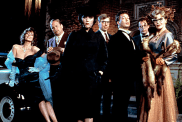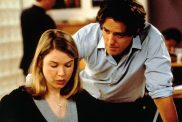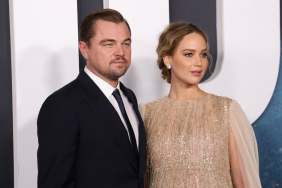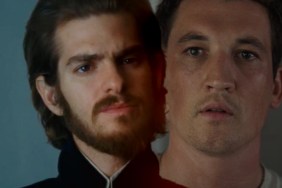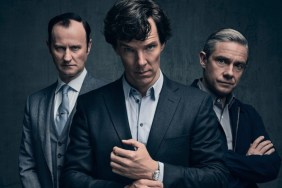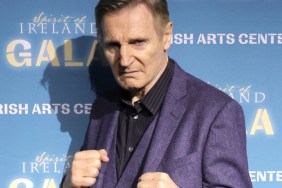
Liam Neeson discusses faith and filmmaking by way of Martin Scorsese’s Silence
Nominated for an Academy Award for its cinematography earlier this week, Martin Scorsese’s 17th century tale of faith and persecution, Silence is now in theaters. An adaptation of the book by Shusaku Endo, the screenplay for Silence was adapted by Scorsese and his Age of Innocence and Gangs of New York writing partner Jay Cocks. Silence brings back another important player from the latter film in the form of Liam Neeson’s Father Cristóvão Ferreira. A real historical figure, Ferreira is a Portugese Catholic priest whose renunciation of the church leads to the beginning of Silence. Andrew Garfield and Adam Driver play a pair of Jesuit priests who embark on a dangerous mission to spread their forbidden faith in Japan and find out the truth behind what happened to Ferreira.
RELATED: Interview: Andrew Garfield on Martin Scorsese’s Silence
CS had the opportunity to speak with Liam Neeson about his performance in Silence and about some of the issues surrounding faith that play out in the story.
A Paramount Pictures release, in association with Fabrica de Cine and Ai Films, Silence also stars Tadanobu Asano, Issey Ogata, Ciaran Hinds, Yosuke Kubozuka and Yoshi Oida.
CS: Faith has been a recurring theme in Martin Scorsese’s films for decades. I was struck watching it that it maybe means something different coming at this point in his filmography versus the same story in a vacuum. Do you see “Silence” as wholly its own thing or does Martin Scorsese’s past work change it all for you?
Neeson: I don’t necessarily see it in his other work. There are certainly characters filled with doubt. I just know “Silence” was a very, very personal project for his own spiritual path in life and the ups and downs of his Catholic faith, which I believe is very strong. But he’s filled with doubt the way we all are. We’re all asking that question, aren’t we? What’s the point of it all. Is there a god? Is there not? Certainly, the older we get, the more we’re looking for answers. The more we’re questing for answers, really, consciously or unconsciously. Since he read Shūsaku Endō’s book in the ’80s, it has been a personal quest of his to bring it to the screen. A man living in New York — an artist living in New York — they run parallel, I think. It was an opportunity to put his spirit and his art in one film.

CS: Of course you previously worked together on “Gangs of New York,” but I’m curious how your first conversation with Martin Scorsese went for this project.
Neeson: I sat with him around September or October 2014. It was just he and I and he talked about Endō’s book. I hadn’t read it then. We talked about both of our upbringings. He was an altar boy. I was an altar boy back in Ireland. I love the whole theatricality of the Catholic church. There’s a celebration of the past, people getting married, baptisms, wearing a costume and candles and incense and stained glass windows. It was incredibly theatrical. It certainly was for Martin, too. But I think the question he still asks himself is what it means to be a man. To try and do good in the world and maybe set an example. Always questing in his art and in his personal life. We talked a little about that.
CS: Had the two of you been planning on working together again for some time?
Neeson: No, no, no. I was on “Gangs of New York” for two and a half weeks or something back in 2000, I think it was. We didn’t get very close. You never really do. He’s very, very busy. It was a five or six-month shoot. I did my time in January or February and left. Can I say I got to know Martin Scorsese? No, not really. We certainly talked about scenes and stuff while we were shooting them, but we didn’t hang out or anything like that.
CS: One of the things I found particularly fascinating about “Silence” was that it focuses on a period of history that I knew very little about.
Neeson: Yeah, me too.
CS: What is the process like when it comes to just educating yourself on the time period?
Neeson: There’s a certain amount of history that you can read. There are various books written about that period and specifically what was happening in Japan. It was a fascinating time, but also a very scary time for anyone who wasn’t Japanese because they did ruthlessly put down Christianity. They were worried about being colonized by Portugal or Spain or whatever country it was. In this case, it was Portuguese. They ruthlessly put down Christianity to set an example.

CS: You’ve done quite a few films set at very different periods in history. Do you enjoy the challenge of blending into another time?
Neeson: I do. It’s always interesting to put yourself back in time. With “Silence” — and with “Gangs of New York”, too, to a certain extent — I am an avid reader. There’s nothing I like more than curling up with a book, be it a history book or whatever. That’s kind of icing on the cake for me, to do the research. Then you marry that with meeting with the costume designer and the set decorator and it’s just wonderful to escape into a time period.
CS: Father Ferreira has an interesting role in the story in that his presence is felt long before he actually appears onscreen. Is that presence something that you are able to influence in any way or is it mostly left to your costars?
Neeson: I try not to play into that. Certainly with Ferreira there’s a certain amount we know about him that exists from the start. He was a well-known Jesuit at the time. He was a scholar, certainly in the field of medicine and astronomy. He could speak various languages as, indeed, many Jesuits did at that time. They were the sons of noblemen. They could speak languages and they were tradesmen. They were philosophers and that made them all the more dangerous to various political authorities. I wanted to play the humanity of Ferreira. That’s what I love about the two or three scenes I’m in. He provides a very, very rational argument to Andrew Garfield’s character. He just lays it all out. These people can’t conceive of a god. Of our god and how we see god. To them, god is the sun up in the sky. That’s what they believe and he knows because he’s been there for 15 to 20 years. I do like his comments very, very much and they come at a very interesting point in the story. I just wanted to portray him as me. I didn’t want to do funny accents. I just wanted to say what Jay Cocks and Martin Scorsese had written because I thought it was pretty damn perfect.
CS: There is a certain weight that you carry with you as an actor simply because audiences associate you so strongly with certain roles. You’ve obviously played deeply religious characters in the past and even allegorical ones like Aslan in “The Chronicles of Narnia” series. Do you need to take into account past roles at all to play a part like this?
Neeson: With regard to other projects, I think every performer and every actor when they pass a certain age has a degree of cinematic baggage with them. You can’t stop that, you know? I think that, in this instance, whatever cinematic aura I have was well used.
CS: There are also some parallels to be drawn between Ferreira and the creature in “A Monster Calls.” Both are sort of there to give the lead information that he doesn’t necessarily want to hear.
Neeson: Giving him some hard truths. Absolutely. I loved that film, “Monster Calls.” It was pretty excellent.
Silence
-
Silence

-
Silence

-
Silence

-
Silence

-
Silence

-
Silence

-
Silence

-
Silence

-
Silence

-
Silence

-
Silence

-
Silence

-
Silence

-
Silence

-
Silence

-
Silence

-
Silence

-
Silence

-
Silence

-
Silence

-
Silence

-
Silence

-
Silence

-
Silence

-
Silence

-
Silence

-
Silence

-
Silence

-
Silence

-
Silence

-
Silence

-
Silence

-
Silence

-
Silence

-
Silence

-
Silence

-
Silence

-
Silence

